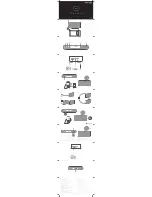
ILER-DDS V2.1 VFO/DDS.
Page 10
Mechanical Installation
Important: Do not rush to make the mechanical installation. It is highly recommended that you
calmly study every possible way to place the DDS assembly block in your rig.
There are some wiring requirements that should be taken into consideration (see "ILER-DDS
Wiring"). Take care when planning the configuration most suitable for your application.
As you can see, the ILER-DDS block is designed to be easily incorporated into any existing rig, being
receivers, transceivers or as a general purpose laboratory RF generator.
Without doubt, there are many ways of implementing the integration of the ILER-DDS on your project.
Mechanically, there are two ways to attach the ILER-DDS block: with screws or with glue. I recommend
using "contact adhesive" on the LCD frame and the box front panel. A thin "line" of glue around the LCD
frame is sufficient. This is an extremely simple and safe method, and provides very good aesthetic
results. If necessary, you can always remove the LCD and clean the glue residue.
Do not use hard to remove adhesives such as cyanoacrylate, epoxy, etc.
In the pictures below, you can see a DDS block installation next to an ILER transceiver. The DDS is
attached with glue. As the LCD is fixed to the panel the other two modules (control board and AD9850
module) can be unplugged when required.
If the space available for the module integration is a bit short the depth of the
sandwich may be reduced by 5-7 mm by directly soldering the LCD to the board,
instead of using male and female headers. Please notice that if board removal is
needed in the future, you will have to unsolder all pins from the LCD or the board.
Note:
The routing and placing of the ILER-DDS wiring may change the "digital noise" perceived (see
"Digital Noise"). For example the supply negative wire; the connection may be done through the shield of
the OUT coaxial cable. If noise is objectionable you will have to proceed with a trial and error denoising
process (see "ILER-DDS wiring").











































